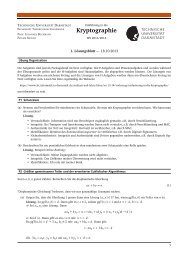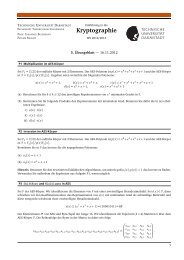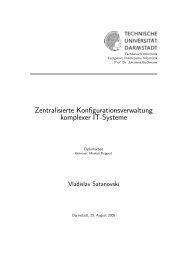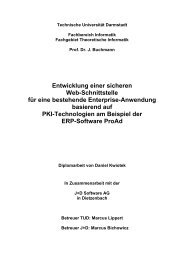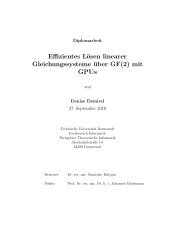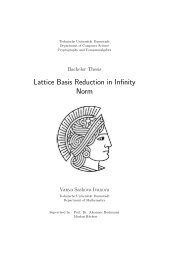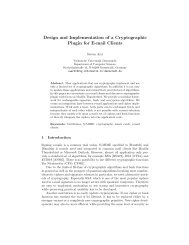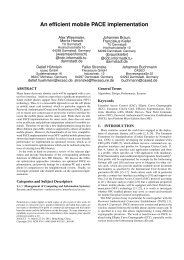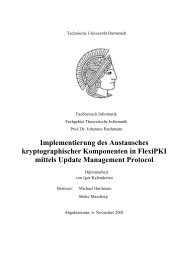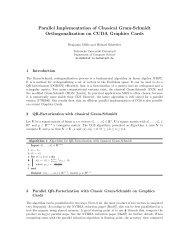Merkle Tree Traversal Techniques - CDC
Merkle Tree Traversal Techniques - CDC
Merkle Tree Traversal Techniques - CDC
You also want an ePaper? Increase the reach of your titles
YUMPU automatically turns print PDFs into web optimized ePapers that Google loves.
2.1.2 Hash functions: The term hash apparently comes by way of analogy with its<br />
standard meaning in the physical world, to "chop and mix" [WK01]. The first<br />
use of the concept was in a memo from 1953, some ten years later the term<br />
hash came into use. Mathematically, a hash function (or hash algorithm) is a<br />
method of turning data into a number suitable to be handled by a computer. It<br />
provides a small digital “fingerprint” from any kind of data. The function<br />
substitutes or transposes the data to create that “fingerprint”, usually called<br />
hash value. This value is represented as a short string of random - looking<br />
letters and numbers (for example binary data written in hexadecimal notation).<br />
By hash functions appears also the term hash collision - the situation when two<br />
different inputs produce identical outputs. Of course the better the hash<br />
function, the smaller number of collisions that occur. Similarly in<br />
cryptography we have a cryptographic hash function, which is simply a normal<br />
hash function with additional security properties. This is needed for their use in<br />
various information security applications, such as authentication and message<br />
integrity. Usually a long string of any length is taken as input and a string of<br />
fixed length is given as output. The output is sometimes termed a digital<br />
fingerprint. One desirable property of cryptographic hash functions is collision<br />
resistance. A hash function is collision resistant it is “infeasible” to find a<br />
collision.<br />
It is trivial to prove that every collision resistant hash function is a one - way function.<br />
Because of this we are going to use hash functions instead of one - way ones.<br />
2.2 Digital signatures<br />
2.2.1 The definition: This chapter considers techniques designed to provide the<br />
digital counterpart to a handwritten signature. A digital signature of a message<br />
is a number dependent on some secret known only to the signer, and,<br />
additionally, on the content of the message being signed. Signatures must be<br />
verifiable; if a dispute arises whether a party signed a document (caused by<br />
either a lying signer, trying to repudiate the signature that the party created, or<br />
a fraudulent claimant), an unbiased third party should be able to resolve the<br />
matter equitably, without requiring access to the signer’s secret information<br />
(private key). Digital signatures have many applications in information<br />
security, including authentication, data integrity, and non - repudiation. One of<br />
the most significant applications of digital signatures is the certification of<br />
public keys in large networks. Certification is a means for a trusted third party<br />
(TTP) to bind the identity of a user to a public key, so that at some later time,<br />
other entities can authenticate a public key without assistance from a trusted<br />
third party. The concept and utility of a digital signature was recognized<br />
several years before any practical realization was available. Research has<br />
resulted in many different digital signature techniques. Some offer significant<br />
advantages in terms of functionality and implementation. In more<br />
9





